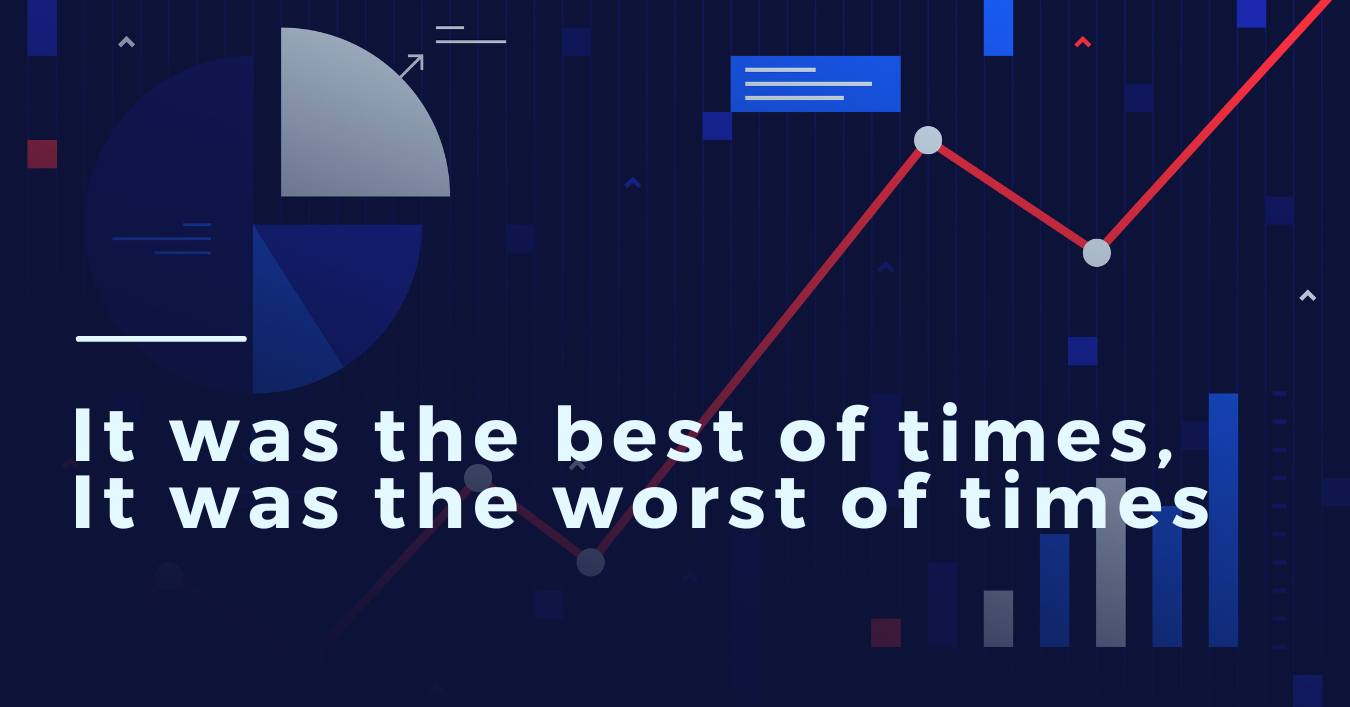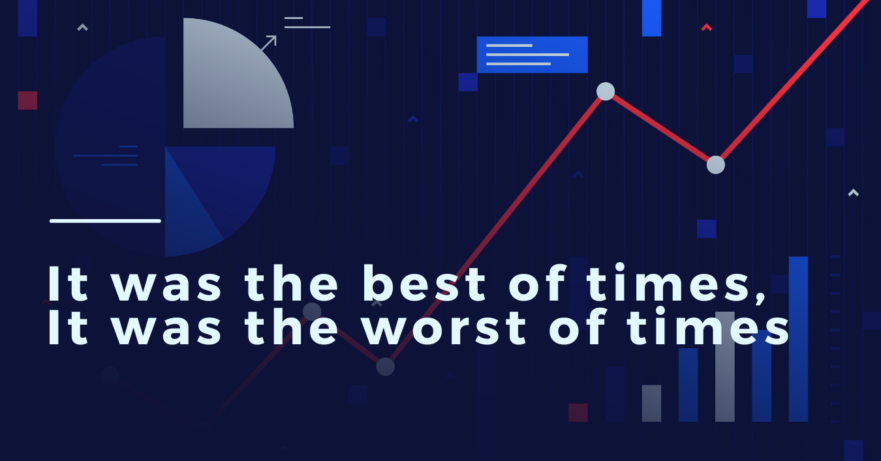
The title of this article is a portion of the opening chapter from A Tale of Two Cities by Charles Dickens. More completely it reads, "It was the best of times, it was the worst of times, it was the age of wisdom, it was the age of foolishness, it was the epoch of belief, it was the epoch of incredulity, it was the season of Light, it was the season of Darkness, it was the spring of hope, it was the winter of despair, we had everything before us, we had nothing before us, we were all going direct to Heaven, we were all going direct the other way--in short, the period was so far like the present period that some of its noisiest authorities insisted on its being received, for good or for evil, in the superlative degree of comparison only." (1)
How can it be both the best and worst of times, the age of wisdom and the age of foolishness, the spring of hope as well as the winter of despair?
I believe the answer lies in the current circumstances everyone finds themselves and the lens though which they view the time period.
I would argue this description is an accurate portrayal of the current situation within our Country, and perhaps many other areas of the planet as well.
To understand the current environment, we must take a look back.
The COVID-19 pandemic changed everything.
On March 19, 2020, California became the first U.S. State to issue a formal “stay at home” order directing its citizens not to leave their homes in order to “protect the health and well-being of all Californians” to slow the spread of Covid-19. From March to May 2020, forty-two additional States and territories issued stay at home orders and directed all “non-essential” businesses to close, impacting nearly 75% of the total population. (2)
The purpose of this article is not to comment either positively or negatively on the actions taken by the government during the Covid-19 pandemic, but instead to discuss several of the still lingering affects these actions have had on the U.S. economy and its citizens.
Prior to the shutdowns the U.S, economy was doing quite well. In January 2020, the unemployment rate had just hit a low of 3.5%, (3) while economic growth was decent at 2.3% (4) and inflation was tame at 2.5% annually. (5) The stock market (as measured by the S&P 500 index) had just hit a high of 3,282 and the outlook seemed rosy. (6)
The pandemic and subsequent economic shutdowns changed this positive outlook in a matter of weeks. Within weeks of policymakers enacting nationwide shutdowns over 20 million Americans were unemployed, economic growth (GDP) had dramatically fallen by 33% and the S&P 500 hit a low of 2,237. (7)
Most of the attention in the financial media was focused on the decline of the stock market. Which kind of makes sense because about 53% of Americans have some form of their assets invested there (mostly through 401k or IRA accounts) and it is the second largest asset exposure for American households behind home ownership at 60%. (8) But it wasn’t just the stock market that reacted negatively. The bond markets, the commodity markets, just about every financial market in the world had some level of meltdown.
To combat this crisis the Federal Reserve (FED) enacted several monetary actions. Their first step was to announce an emergency rate cut of 50 basis points (1/2 of 1 percent) to their target interest rate. When that didn’t have much effect, they quickly followed up by bringing interest rates down to essentially zero and implementing liquidity programs designed to assist the daily activity of the commercial paper and money markets.
But these actions didn’t stem the crisis in the financial system, so the Fed then decided to go all in. They convened an emergency meeting and announced they would provide “unlimited” monetary assistance and with the help of the U.S. Treasury would fund securities like corporate and municipal debt, certificates of deposit, student loans, auto loans, etc. They also announced the creation of financial assistance programs to help small and medium sized businesses meet payroll.
These were historic actions for sure. To put all this into context, during the seven years following the Financial Crisis of 2008, the Fed kept interest rates at essentially zero and funneled about $3.5 trillion in excess liquidity into the financial system through various programs. (9) Fast forward to 2020, and the Fed pumped about $3 trillion into the financial system in a little more than three months! (10) By the end of 2021, the Fed had provided excess liquidity to the financial system and bloated its balance sheet to the tune of almost $5 trillion. (11)
But the fed wasn’t the only actor in this play. The U.S. government stepped into the mix by enacting several “stimulus” packages (the CARES Act, CARES Act 2, American Rescue Plan and the American Infrastructure Plan). Some of these continue to be implemented today and when finished will total almost $7 trillion in spending. (12)
There are significant and lasting aftereffects of the shutdowns and financial intermediation that we are seeing today and will most likely experience for quite a few years into the future.
You can’t just stop the global economy and then expect it to start it up again without some immediate and longer lasting impacts. Especially in today’s world-wide economic environment in which production of finished goods doesn’t often happen within a localized geographic area. In many cases, production of these goods requires dozens, and maybe even hundreds of different suppliers often located in different regions or even different countries.
An immediately identifiable aftereffect of the pandemic shutdowns and slow re-opening was the disruption to the supply chain and the resulting shortage in seemingly everything from shipping containers to semiconductors. The predictable impact once the global economy began to emerge from the shutdowns was higher prices for nearly every type of raw material and finished goods. Basic economics says if you reduce supply and increase demand, you get higher prices.
Adding to the upward pressure this supply shortage caused was the pandemic altered behavior by consumers everywhere. Having just experienced a dramatic shock that altered their perception of their possible life expectancy, many opted to make their dream purchases immediately rather than waiting until some distant point in the future. The rush to buy better homes, new cars, add swimming pools or home theatres pushed consumer demand significantly above normal levels.
Another unintended consequence of the pandemic was the change in the U.S. labor force. The combination of forced confinement at home, more widely acceptable video conferencing and the government supplying stop gap income in the form of “Economic Impact Payments” gave many the opportunity to re-examine their current employment and decide if it was what they wanted to do with their lives. Even now, almost four years after the end of the lockdowns, some industries still struggle to return to their pre-pandemic levels of employment.
These factors all combined to produce an historic uptick in the level of inflation. The level of inflation soared from an annual level of 2.5% immediately pre-pandemic to reach a peak of 9.1% in June 2022. (13) This increase in cost impacted the prices of finished goods in just about every element of the economy and hit those in the lower income echelons hardest.
Ok, I know this didn’t cover every potentially important factor, and it was getting a bit long-winded, but I think it provides enough historical context to understand the implications of the long-term changes developing. Allow me to illustrate some examples of how the very same factors can impact different segments of our society in different ways. The “best of times” for some, and the “worst of times” for others.
Higher levels of inflation and higher nominal interest rates are a positive for some members of our society. Those that have significant investment assets (stocks and cash) are seeing a benefit from the higher levels of stock prices and the increased income generated by higher yields on traditional income assets. For example, when yields were 0.25% a person with $1,000,000 in savings earned a measly $2,500 per year interest. But with short term rates currently around 5%, that same $1,000,000 in savings throws off a hefty $50,000 annually. The best of times.
Contrast that with the group that doesn’t have large amounts of investment or liquid capital (estimated to be about 70% of the population). (14) The higher interest rates mean higher credit card payments, higher mortgage loan rates and less access to capital as lenders tighten lending standards as the cost of money rises. The worst of times.
Let’s talk about higher levels of inflation for a minute. For most of the population that earns their daily bread from a regular job (not the CEO of a Fortune 500 company) higher levels of inflation brought on by the factors cited earlier have negatively impacted their ability to maintain their standard of living. In fact, in a CBS poll in December 2023, 76% of those surveyed said they felt their incomes weren’t keeping up with the rising cost of living. (15) Sadly, the worst of times.
But those wealthy enough to have significant income from their investments, have seen a sharp increase in that income beyond the increase in the level of inflation. After all, even if inflation has increased from 2.3% annually pre-pandemic to 3.4% annually as of the latest reading, that’s going to have a paltry impact if the yield on your assets has gone from 0.25% to 5% annually. Again, the best of times.
Inflation also impacts the cost of housing, which is typically one of the largest components in a household budget. Rents tend to increase faster during rising inflationary periods as the cost of maintaining the properties goes higher. A large negative for those not owning their place of abode. Even for those that are trying to make the leap from renting to owning, higher inflation (coupled with lower supply due to those benefiting from low-rate mortgages reluctance to sell) pushes up the prices faster than they can save for a down payment. Yep, you guessed it – the worst of times.
However, for those who already own a home during a rising inflationary period, they will see the benefit of their home value rising at a faster rate. Though they may not realize this benefit until some point in the future when they decide to sell, and in the meantime may be faced with higher real estate taxes. Maybe not the best, but certainly not the worst of times either.
How long will the current cycle of higher inflation and higher than recent historical interest rates continue? I don’t know. Nobody does. The only thing certain is that at some point it will change. The factor that will bring on that change is also unknown, but we can speculate based on history. Most likely it will either be the realization that “something” in the financial system has broken, or the economy takes a nosedive into a recession.
That will trigger a deflation in risk assets (stocks, real estate, gold, et cetera) and the policymakers will step in with the same type of monetary policies and stimulus programs hoping to stem the tide. But the economic cycles tend to be long. For example, the Covid-19 impact, which historically was one of the shortest shifts from a deflationary crash in hard assets to a rising inflationary trend, took about 18 months.
In the meantime, if you are managing a portfolio of investment assets for your future, the best advice I can offer is to conservatively manage within the environment you have and keep your eyes open for any signs of the winds of change.
Footnotes:
- https://www.goodreads.com/book/show/1953.A_Tale_of_Two_Cities
- https://www.cdc.gov/mmwr/volumes/69/wr/mm6935a2.htm
- https://fred.stlouisfed.org/series/UNRATE
- https://fred.stlouisfed.org/series/GDP
- https://fred.stlouisfed.org/series/CORESTICKM159SFRBATL
- https://fred.stlouisfed.org/series/SP500
- https://fred.stlouisfed.org/series/UNEMPLOY
- https://fred.stlouisfed.org/series/RHORUSQ156N
- https://fred.stlouisfed.org/series/WALCL
- https://fred.stlouisfed.org/series/RESPPANWW
- https://fred.stlouisfed.org/series/RESPPANWW
- https://www.pandemicoversight.gov/data-interactive-tools/data-stories/update-three-rounds-stimulus-checks-see-how-many-went-out-and
- https://fred.stlouisfed.org/series/MEDCPIM158SFRBCLE
- https://www.bankrate.com/banking/savings/emergency-savings-report/
- https://www.cbsnews.com/news/cbs-news-poll-inflation-impact-living-standards-opportunity-2023-12-10/






